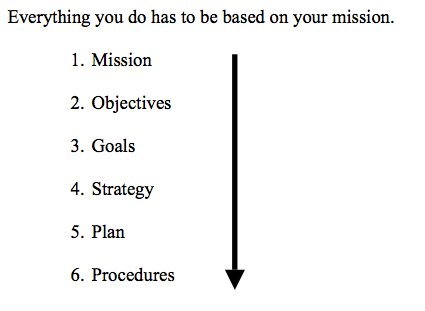Entrepreneurship and Intrepreneurship: Making it Happen
1. The Big Picture: Making it Happen![]()
2. The “Intrepreneur”
3. Issues of the Intrepreneur
4. Rules of Effective Intrepreneurship
5. Process for Entrepreneurship
6. Rules for Entrepreneurship
7. Initial condition Checklist
8. Lessons Learned (more rules)
9. Rules (at least the big ones)
1.The Big Picture: Making it Happen
Rule: “If you don’t know where you are going, you won’t get there”.
Ref: Yogi Berra
2.The “Intrepreneur”
Definition: “Intrepreneur”: An Entrepreneur-like individual who works inside a large company, and acts to get things done, to manage large critical projects, and/or to develop new products. These individuals usually start as successful project managers.
These guys have the same set of issues, except:
• Lower personal risk
• Lower personal reward
• Their efforts must be aligned with their company’s objectives (even if these objectives change)
Biggest difference to the Entrepreneur is usually:
“Hey, it’s not my money”
Rule: “For an intrepreneur to succeed, he MUST sincerely believe it is his money.”
3.Special issues of the Intrepreneur:
1. Your business opportunity must be perceived by management to be of strategic interest to your company.
a. Your company is in a particular business, and going in a particular direction. The company will not usually support new business efforts, unless aligned.
2. The opportunity must reward the decision makers in some fashion, e.g.
a. It will provide profitability at some point in the future
b. It will provide an opportunity for a significant capital gain
c. It will provide relationships, which could be synergistic with the company’s other business.
3. You will be amazed at the “price”
a. Everyone in the decision chain has a price to support your efforts
b. Successful intrepreneurs are able to detect this, and adjust
4. Of course, the entrepreneur has these same issues.
a. The primary difference is that he can shop around.
Rule: “It is often easier to apologize than to ask permission”
The Issues of the Intrepreneur:
1. Relationship Management (one of the cornerstones)
a. External Relationships: Your customers, who will buy your product
b. Internal Relationships: Your company and others (boss, government, etc), who gives you the permission to sell your product or services
2. For the Intrepreneur, “Internal Relationship Management” is a core skill.
a. Your opportunity to shop for investors, team members, and employees is often restricted
b. You protect yourself with a good business plan.
3. Your corporate culture is often already established
a. Learn it, and work with it.
b. If it is inappropriate to the venture, address this up front. You cannot be successful with an inappropriate corporate culture.
c. (Ditto for an inappropriate cost and accounting structure.)
4. Communication requirements are more severe.
a. Up, up, up, (and down) the organization
b. Measurables must be set and agreed to, appropriate, and long lasting.
c. You absolutely must have an “internal board of directors” to succeed. Otherwise, you are at the whim of individuals, who are expected to change frequently.
i. What will happen to you when the King dies?
ii. It is difficult to succeed in a monarchy.
4.Rules for Effective Intrepreneurship:
1. Understand your corporate culture
2. Build relationships
a. Especially internal relationships
3. Know the profit drivers in your industry
a. E.g. Revenue per employee, how it compares to competition
4. Thoroughly understand your competitors
5. Master your budget
a. Speak your company’s accounting language fluently
6. Take initiative
7. Provide vision
a. Align your vision with that of your company
8. Broaden your skills
a. Successful Intrepreneurs have a “large bandwidth”
Ref: G. Macdonald notes, July 1998
Rules:
• All organizations become “Intrepreneurial” very rapidly after startup.
• “Entrepreneurship is getting it started, Intrepreneurship is getting it done”
5.“Process” for Entrepreneurship:
There are many, many ways to start a new venture. All approaches wrestle with the issue of collecting opportunity, team and money at the same place at the same time.
A process that seems to work for both Entrepreneurs and Intrepreneurs:
1. Formulate the idea / opportunity
a. In fairly broad terms
b. Performed by the entrepreneur or a small group
2. Review the opportunity with others, incl. possible team
a. Sensibility checks
b. Refine the concept
c. Coalesce the team around the idea, get buy-in
d. “If we can get funded, I’m committed”
3. Review with potential money sources
a. Is this a fundable concept?
b. Refine to a fundable concept with the potential team
c. Get buy-in from the money sources (usually Angel level)
d. Try to get sensibility check from real professional (VC or equal)
4. Get commitments (usually verbal), subject to a final plan
a. Sometimes only a commitment to help find team / money
5. Write plan
a. Collect commitments and get started
b. Check “Initial Conditions” are set properly (Appendix H)
Rule: “All key participants must have an opportunity to “make their mark” on the plan or they won’t buy-in.”
6.Initial Condition Checklist:
Much like a chemical reaction, startups, spin-outs, and new ventures are subject to a set of “initial conditions”, which if right, allow the reaction to occur. If wrong, either nothing happens or the venture is crippled. The list below is a (partial) checklist of necessary initial conditions that either must be met, or the reason “why not” clearly understood and agreed.
1. Ownership and reward structure
i. Defined and clear
ii. Fair to all participants – (properly rewards relative risk)
iii. Schedule for future investment clear
iv. Make-it-happen Team adequately rewarded
v. No residual “resentment” by any key participants
2. Intellectual Property
i. IP edge clear
ii. Engine for IP growth in place
iii. Ownership of IP clear
iv. Licenses acquired (as necessary)
v. Patents under control and appropriate (esp. cost)
i. Passes review for defense and work around
3. Team
i. Someone driving the bus with strong success contract and/or ability
ii. Team “signed on” to the leader (Firmly behind and pushing)
iii. High sense of urgency
iv. No “team” fatal flaws (see list Appendix D)
v. Necessary Partners identified
vi. Necessary Suppliers identified
vii. Core team positions filled (at least temporarily)
viii. Commitment of key team members clear
ix. Card deck of core responsibilities dealt out (Chairman, Pres, CEO, COO, CFO, VP Sales, CTO)
4. Business Model
i. Value proposition clear and viable
ii. Proposition validated with key customers or prospects
iii. 10 key customers identified, including sales process
iv. Distribution plan viable
v. Adequate market size and access
5. Investment
i. Opportunity scores >45 on Investment Screen (Appendix D)
ii. If low, actions to fix identified (partners, team, time, milestones)
iii. Type of investors clear (more than money)
iv. Future investment rounds identified (when, how much)
v. Money raising plan reasonable (raise when you don’t need it)
vi. Exit plan clear and identified
6. Organization
i. Corporate Culture appropriate
ii. Cost accounting appropriate
iii. Location appropriate
iv. Physical space appropriate
v. Contracts with key team in place
vi. Team safety net adequate
vii. Sense of family (team) established
viii. Lines of authority clear
ix. No restriction on team ability to act.
7. Command and Control
i. Board of Directors clear
ii. Decision process clear
iii. Dashboard identified
iv. Communication plan clear
v. Employee support and benefits clear and appropriate
vi. Employee handbook in place (use std if available)
There are clearly others, which may vary slightly based on the business and situation. However, the above list should get you started.
7.Rules for Entrepreneurship:
1. Do your learning on a small scale, and on someone else’s money.
a. Learn project management from the best organizations
b. Succeed first with a project or a “craft”. If you can’t make money selling birdfeeders, you are unlikely to handle the big one
2. Good Ideas are a Dime a Dozen
a. Most important is the team to make it happen
b. You must have a “make it happen” mentality
3. You need money
a. Must be wealthy, or find partners
b. If you are wealthy, don’t do it. (lack motivation)
4. Your Partners must give you room to fail, if you are to succeed
a. Money partners
b. Corporate partners
c. Technology partners
d. Manufacturing partners
5. Hire the best people you can find
a. Take care of them
b. Give them leadership
c. They will take care of the business
6. A little luck goes a long way
7. Have fun along the way.
a. In Eldorado, the streets are paved with gold.
8.Lessons Learned:
1. Half a pie is better than none. Cut your deal and get to work.
2. Keep your credibility, integrity and morality impeccable
3. Pick partners who are moral
a. If a verbal agreement is not sufficient, get another partner, or a lawyer
b. Use lawyers sparingly
4. Get help. Know and set your limits
a. You must partner and delegate
b. You can’t do it all yourself
5. When you see problems, fix them early, especially
a. Integrity
b. Company direction
6. Always keep your eye on the future
a. Know your goals,
b. Measure your progress
7. The primary goal in business is NOT money
a. It is to satisfy the ego needs of those in charge
b. KNOW the ego needs of your partners
8. The normal resting-place for most ventures is Purgatory. Be careful you don’t get stuck there.
9.Rules
• For an Intrepreneur to succeed, he must sincerely believe it is his money
• Good ideas are a dime a dozen
• Get buy-in from key participants early and often
• Keep your ethics impeccable
• Use lawyers sparingly
• Take care of your people
• The primary goal of business is NOT MONEY. Know the ego needs of your partners.



